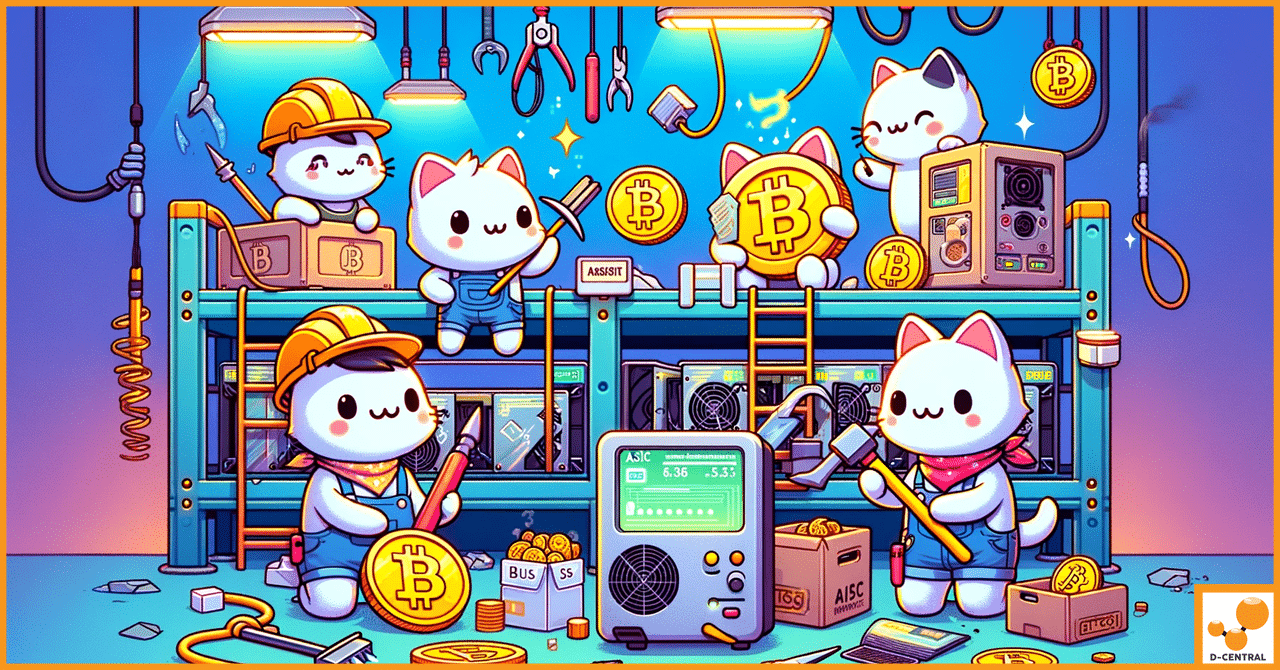
The Role of Home Miners in Bitcoin Governance: Participating in the Ecosystem
Discover how home miners contribute to Bitcoin’s decentralized network and learn about D-Central’s innovative mining solutions for enthusiasts and professionals
4479 Desserte Nord Autoroute 440, Laval, QC H7P 6E2

Welcome to the comprehensive guide on solo Bitcoin mining! Whether you’re a seasoned miner looking to go independent or a curious newcomer eager to dive into the world of cryptocurrency, this guide will equip you with the knowledge and tools you need to succeed in solo mining. Discover the potential rewards, understand the challenges, and learn how to optimize your mining setup for maximum efficiency.
Solo Bitcoin mining is a specific form of cryptocurrency mining, where you attempt to mine new bitcoins independently rather than as part of a pool. This guide will focus on the unique aspects of solo mining Bitcoin compared to other types of cryptocurrency mining.
Bitcoin mining is the cornerstone of the Bitcoin network, serving as both a method for introducing new bitcoins into circulation and a crucial mechanism for securing and verifying transactions on the blockchain. Let’s delve deeper into the intricacies of this fascinating process.
At its core, Bitcoin mining involves solving complex cryptographic puzzles to validate transactions and add new bitcoin blocks to the blockchain. This process, known as Proof of Work (PoW), ensures the integrity and security of the Bitcoin network, as miners compete to solve bitcoin blocks through proof-of-work.
In solo mining, miners validate Bitcoin transactions by solving these cryptographic puzzles independently. Solo miners work on their own to find blocks, and the process of finding blocks is highly competitive and challenging. Miners compete to solve these puzzles, and the first one to find the solution gets the privilege of adding the next block to the chain, along with a reward in the form of newly minted bitcoins and transaction fees.
As of 2024, the block reward for successfully mining a block is 6.25 BTC, plus any transaction fees included in the block. This reward serves as an incentive for miners to continue dedicating their computational resources to the network. It’s worth noting that the block reward halves approximately every four years in an event known as the “halving,” which helps control the rate of new bitcoin issuance and maintains the cryptocurrency’s scarcity.
Did You Know? The total supply of Bitcoin is capped at 21 million coins. As of 2024, over 19 million bitcoins have already been mined, leaving less than 2 million to be introduced into circulation. This scarcity is one of the factors contributing to Bitcoin’s value proposition.
When it comes to Bitcoin mining, you have two primary options: solo mining and pool mining. Each approach has its own set of advantages and challenges. In pool mining, miners may need to pay pool fees and other associated costs, which can affect their overall earnings. Let’s explore both to help you make an informed decision.
Solo mining involves an individual miner attempting to solve blocks independently, without joining a mining pool. This approach offers the potential for significant rewards but comes with higher risks and challenges.
Pool mining involves joining forces with other miners to combine computational resources and increase the chances of solving blocks collectively. Rewards are then distributed among pool members based on their contributed hash power.
Making the Choice: Solo or Pool Mining? The decision between solo and pool mining depends on various factors, including your available hash power, risk tolerance, and mining goals. Solo mining offers the potential for larger rewards but requires substantial resources and a higher tolerance for risk. Pool mining provides more consistent earnings but with smaller individual payouts. Consider your circumstances carefully before making a choice.
In the world of solo mining, hashrate is the single most important factor determining your chances of success. Hashrate measures the speed at which your mining hardware can process complex mathematical equations required to validate bitcoin transactions and add new blocks to the blockchain. The higher your hashrate, the greater your probability of being the first to solve the cryptographic puzzle and claim the coveted block reward.
For solo miners, competing against large mining farms and other miners on the bitcoin network means that every bit of mining power counts. ASIC miners, such as the Antminer S21, are specifically designed to deliver high hashrates, making them a popular choice for those looking to solo mine bitcoin efficiently. However, achieving a competitive hashrate comes with significant considerations—namely, the upfront cost of mining equipment and ongoing electricity costs. These factors directly impact the profitability of your solo mining operation.
To maximize mining efficiency, solo miners must carefully balance their investment in powerful ASIC miners with the cost of electricity and the current network difficulty. Unlike mining in a pool, where rewards are distributed more frequently but in smaller amounts, solo mining offers the potential for a full block reward, but only if you are the first to find a new block. This makes optimizing your hashrate crucial for increasing your chances of success while managing operational expenses.
Ultimately, understanding and optimizing your hashrate is key to thriving as a solo miner. By investing in efficient mining hardware and monitoring your electricity usage, you can position your solo mining operation for the best possible chance of discovering new blocks and earning substantial rewards.
Solo miners are essential guardians of the bitcoin network, playing a direct role in validating transactions and maintaining the integrity of the blockchain. Through the mining process, solo miners use specialized mining software and powerful hardware to solve cryptographic puzzles. Each time a solo miner successfully solves a puzzle, they validate a group of bitcoin transactions, package them into a new block, and add it to the blockchain.
This process not only earns the solo miner the full block reward and any transaction fees included in the block, but also strengthens the security and decentralization of the bitcoin network. Unlike pool miners, solo miners operate independently, giving them full control over their mining operations and the transactions they choose to include in each block. This independence means solo miners are responsible for all aspects of their mining setup, from configuring mining software to maintaining hardware and managing electricity costs.
By dedicating their computing power to the network, solo miners help ensure that no single entity can dominate the flow of transactions or compromise network security. Their efforts make it more difficult for malicious actors to manipulate the blockchain, as each new block requires significant computational work to be validated and added. In this way, solo mining not only offers the potential for substantial rewards, but also contributes to the robust, decentralized nature of bitcoin.
Participating in solo mining means taking on the risks and costs associated with running your own mining operation, but it also means playing a vital role in the ongoing security and trustworthiness of the bitcoin ecosystem. With full control over your mining process, you become an integral part of the network, helping to validate transactions and secure the future of bitcoin.
Successful solo mining requires powerful and efficient hardware to compete in the current mining landscape. Over the years, various devices such as ASIC miners, CPUs, GPUs, and FPGAs have been used for Bitcoin mining, but ASIC devices are now the standard for efficient solo mining due to their superior performance and energy efficiency.
The choice of device significantly impacts mining efficiency, stability, and overall performance. Some mining equipment, like the Mars Lander V2 lottery miner, is considered bitcoin merch, appealing to beginners and enthusiasts for its branded features and user-friendly design.
Let’s explore some of the top ASIC (Application-Specific Integrated Circuit) miners available for solo Bitcoin mining, with a focus on D-Central’s offerings.
The Bitaxe series, designed by Skot9000 and part of the Open Source Miners United (OSMU) product line, offers a range of efficient and customizable mining solutions. D-Central Technologies is one of the largest manufacturers and distributors of the Bitaxe product line.
Why Choose Bitaxe for Solo Mining? The Bitaxe series offers a perfect blend of efficiency, customization, and open-source innovation. These miners provide excellent performance-to-power ratios, making them ideal for solo miners looking to maximize their chances of success while minimizing operational costs.
The Antminer series, produced by Bitmain, is known for its high-performance miners suitable for both industrial and home mining setups. The Antminer S21, for instance, can process 270 terahashes per second (TH/s), making it one of the most powerful options available. D-Central offers customized versions of these miners optimized for home use.
Check Out Antminer Slim Edition
D-Central offers unique mining solutions that combine efficiency with practicality, perfect for home miners and those looking to optimize their space and energy usage.
Learn More About S9 Space Heater Edition
Now that we’ve covered the essential hardware, let’s walk through the process of setting up your solo mining operation. This comprehensive guide will help you get started on your journey to becoming a successful solo Bitcoin miner.
server=1
rpcuser=yourusername
rpcpassword=yourpassword
rpcallowip=127.0.0.1
To maximize your chances of success in solo mining, it’s crucial to optimize every aspect of your operation. Here are some key strategies to enhance your mining efficiency and profitability:
Solo mining can be highly rewarding, but it’s essential to understand the economic factors at play to make informed decisions and manage your expectations.
Mining bitcoin requires understanding both the technical and economic aspects, including hardware, electricity, and network conditions. When mining bitcoin as a solo miner, it’s important to be aware of the minimum difficulty setting. The minimum difficulty determines whether your mining shares are detected and reported by the network or mining pool. If your hashrate is too low to surpass this threshold, your shares may not be recognized, impacting your chances of earning rewards. Ensuring your setup can meet or exceed the minimum difficulty is crucial for effective participation in solo mining.
To determine the potential profitability of your solo mining operation, consider the following factors:
Use these factors to calculate your expected returns and break-even point. Remember that solo mining profits can be highly variable due to the nature of block rewards.
When engaging in solo mining, it’s crucial to understand and manage your expectations:
Solo Bitcoin mining offers the potential for significant rewards and contributes to the decentralization of the Bitcoin network. However, it also comes with challenges and risks that require careful consideration.
If you have access to low-cost electricity, can invest in powerful mining hardware, and are comfortable with the high variance in rewards, solo mining might be a suitable option for you. It’s particularly appealing for those who value independence and want full control over their mining operation.
On the other hand, if you prefer more consistent returns or have limited resources, pool mining might be a more appropriate choice.
Ultimately, the decision to engage in solo mining should be based on a thorough assessment of your resources, risk tolerance, and long-term goals in the Bitcoin ecosystem.
Explore D-Central’s range of mining solutions tailored for solo miners. From the innovative Bitaxe series to customized Antminer setups, we have the tools you need to succeed in your solo mining venture.
DISCLAIMER: D-Central Technologies and its associated content, including this blog, do not serve as financial advisors or official investment advisors. The insights and opinions shared here or by any guests featured in our content are provided purely for informational and educational purposes. Such communications should not be interpreted as financial, investment, legal, tax, or any form of specific advice. We are committed to advancing the knowledge and understanding of Bitcoin and its potential impact on society. However, we urge our community to proceed with caution and informed judgment in all related endeavors.
Related Posts

Discover how home miners contribute to Bitcoin’s decentralized network and learn about D-Central’s innovative mining solutions for enthusiasts and professionals

In the dynamic world of cryptocurrency mining, Application-Specific Integrated Circuit (ASIC) miners have emerged as pivotal tools for anyone serious

In recent years, the tech industry has been grappling with a significant GPU shortage. This scarcity has been widely attributed